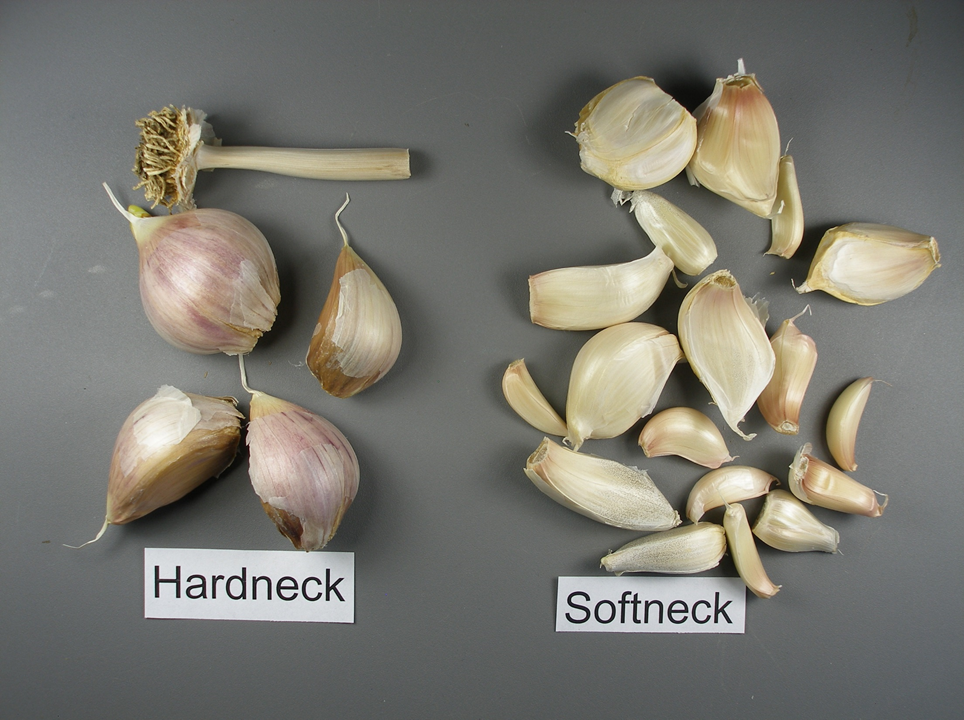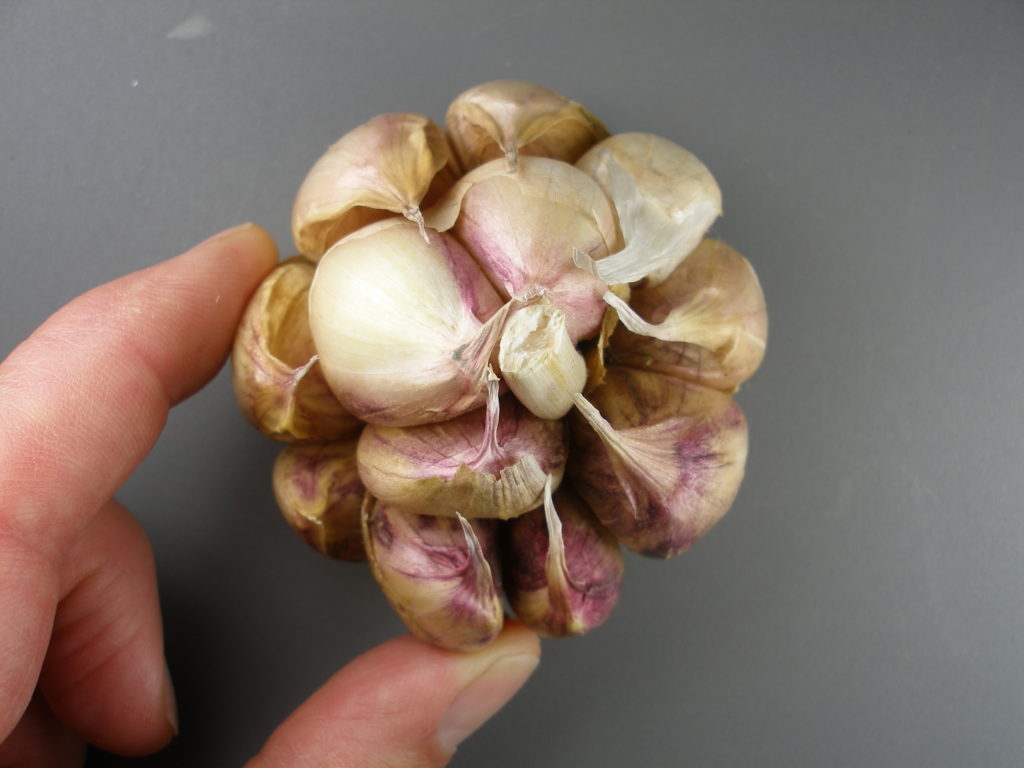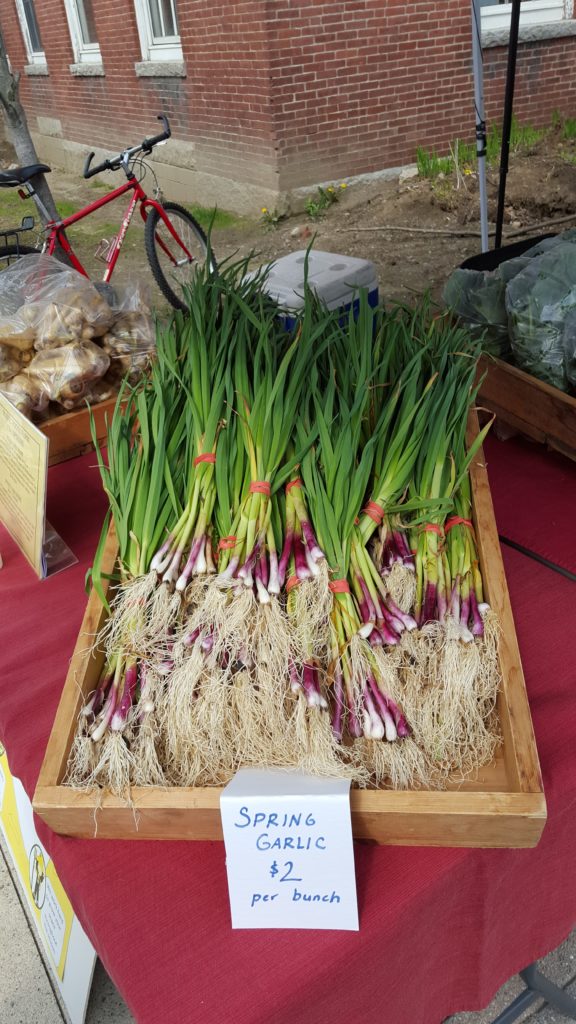A guide to the different types of garlic

Beloved for its culinary uses (not for its breath effects), garlic is a great addition to any garden. The plant is hardy and easy to grow and used in many different cuisines.
There are many different types of garlic to choose from, each with their own uses and distinct ways to grow and harvest them. Here are the main ones you should know.
Hardneck garlic
Hardneck garlic (Allium sativum ophioscorodon) are characterized by woody central stalks and a green curly stalk, also known as a scape. Hardneck garlic forms cloves through a process of vernalization, whereby the garlic is exposed to cold temperatures by staying in the ground over the course of the winter. There are usually between four and twelve cloves in each bulb.
“People tend to like big bulbs,” said David Fuller, agriculture and non-timber forest product professional at the University of Maine Cooperative Extension. “When well grown, hardnecks grow pretty big bulbs.”
Hardneck garlic grows best in areas with cold weather conditions.
“Hardnecks are the ones that are typically grown in Maine,” Fuller said.
You may see hundreds of varieties of garlic on the market with different colors and flavors. Fuller explained that garlic is grown by planting cloves directly into the ground, so it is fairly easy to develop a new varietal with a slightly different taste depending on the environmental conditions where they are grown.
All these varieties can generally be categorized into one of less than a dozen groups, though. A 2004 study showed that the genetic fingerprints of 211 different varieties of garlic could basically be put into ten groups, eight of which are hardneck garlic: the robust, slightly sweet Rocambole; the hot, sulfurous Porcelain; the tasty, raw Purple Stripe; the hardy, bakeable Marble Purple Stripe; the plump, glossy Asiatic; the succulent, easily-harvested Turban; the rosy, warm Creole and richly violet, quickly maturing Glazed Purple Stripe.
The varieties within each of these groups may look and taste slightly different, but they are essentially genetically the same.
“People will rename them. A [Porcelain hardneck] garlic that was discovered in Philips, Maine, lo and behold, will become Philips garlic,” Fuller said. “Along with Music and German Extra Hardy [which are also Porcelain hardneck garlics], it’s pretty much the same garlic it’s just been given a different name.”
Softneck garlic

If you shop for garlic in a supermarket, you are likely to come across softneck garlic (Allium sativum sativum). Softneck garlic produces more cloves than hardneck garlic and usually has a clove in place of the signature woody scape, but they are generally less flavorful than their hardneck counterparts.
“The advantage of soft versus hard is that with the softneck, you can braid it, whereas a hardneck will have a scape, which is hard and woody,” Fuller said. “Hardneck garlic is difficult to braid because you have to break the neck.” Though the braid is strictly decorative, Fuller said it is a fun way to display and easily access garlic, especially for a rustic farmhouse kitchen look.
Softneck garlic does not require as much cold exposure are hardneck garlic.
“Soft[neck] garlic is mainly grown in the south,” said Bob Westerfield, senior public service associate at the University of Georgia Extension. “The hard[neck] type likes cooler climates.”
The two main groups of softneck garlic are Silverskin, which is high-yielding, adaptable and the kind that you are most likely to see braided, and Artichoke, which has a thick outer layer and a longer shelf life. Softneck garlic is also used for processed garlic foods, like garlic powder and other seasonings.
Garlic Scapes
Though the basic categories of hardneck and softneck garlic encompass all true garlic, there are different ways to harvest garlic that you may see on your dinner plate or on the stands of your farmers market or grocery store.
One way is to harvest the garlic scapes from hardneck garlic in the spring. The scape is the flowering stalk that grows in the middle of hardneck garlic bulbs. If left to grow, the green stem will curl and form a white bulb, but it is usually removed so that the plant will not produce more seeds and will instead grow a bigger bulb.
Fuller said to harvest the scapes when they first come up, before the stem gets woody.
“I am a proponent of harvesting it as soon as you can,” Fuller explained. “Snap it off in the morning when the plant has more turgor, so you can snap them right off. I don’t recommend waiting until the curl because the later you wait, the harder the scape gets.”
Luckily, scrapped scapes — which are also widely available at farmers markets — can be reused in your kitchen. They are delicious, tender and crisp sauteed in butter or olive oil with salt.
“They’re great in pesto,” Fuller said. “People pickle them and use them in stir fries”
Spring garlic

Spring garlic, or green garlic, which commonly appears on farmers markets during the summer, is another method of growing garlic. Instead of planting garlic in the fall and letting it vernalize to form cloves, plant garlic in the spring and harvest it at the end of the summer.
Spring garlic looks like scallions and has a fresh, mild and almost nutty flavor. Spring garlic is common in Asian cuisine can be used as a substitute for leeks, scallions, chives or garlic in a recipe (one stalk, Fuller said, is about equal to one clove). Fuller, personally, recommended chopping spring garlic up and sauteeing it with scrambled eggs.
Not quite garlic …
Wild garlic
There are also a few plants that are called garlic that are not technically classified as garlic.
You can forage for wild garlic (Allium vineale), which has a strong flavor and can be used to flavor broth or for a number of medicinal benefits. However, in many areas, wild garlic is considered a weed and is not consumed.
“Wild garlic is a bad turf weed in the South,” Westerfield said. “While I understand it is not poisonous, it is reported to have a very strong and bad flavor.”
Though more closely related to onions, ramps (Allium tricoccum), sometimes called wild onions or wild leeks, have a strong flavor somewhere between an onion and garlic. They are a versatile ingredient that can be blanched, pickled, fried, sauteed or cooked into a number of dishes.
“You see them in high end restaurants come springtime,” Fuller said. “It’s more of a thing that people forage, although you can grow them. Ramps reproduce very slowly, so I recommend people to pick them with great conservation in mind. Remove one leaf out of the two, don’t dig up the whole plant so it will keep on living.”
Elephant garlic
Elephant garlic (Allium ampeloprasum), also sometimes known as buffalo garlic, is actually a misnomer: the enormous bulbs are actually a type of leek. The bulb forms a few cloves and is generally milder than most garlics. It is often interchangeable with softneck garlic when cooking, tastes delicious roasted and works especially well in sauces, vinaigrettes and stir fries.
“The more tender, fleshy lower portion of the seedstalk is also prized as a stir-fried vegetable,” Westerfield said. “The flavor is milder than garlic and can be slightly bitter. Elephant garlic grows under the same conditions as regular garlic.”
Unfortunately, the comically large bulbs can be difficult to grow in cold climates.
“That’s not reliably hardy so I’m not a big fan of that in terms of trying to grow it in Maine,” Fuller said. “Maybe in the southern part of the state, but not in Bangor.”
Knowing the difference between the different things that are known as “garlic” — whether they are actually garlic or not — will help you be a more informed grower, shopper and user of the tasty allium.

I read through this article and found it very interesting. However, I never found out who “Fuller” was.